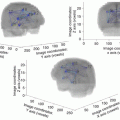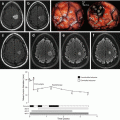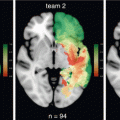Molecular markers
Prevalence (n > 1000 glioma subjects) (%)
IDH mutation only
45
Triple-positive [TERTp-mut, IDH-mut, 1p/19q codeletion]
29
TERTp-mutation only
10
Triple negative [TERTp- wild type, IDH-wild type, 1p/19q intact]
7
TERTp-mut and IDH-mut
5
There are five key aspects to glioma molecular stratification and prognostication to be noted here:
- 1.
- 2.
- 3.
Gliomas with only TERTp mutations are primarily glioblastomas, with triple-negative gliomas comprising 7% of grade II/III gliomas and 17% of grade IV tumors [30].
- 4.
Triple-negative gliomas typically do not acquire ATRX mutations. It is relatively rare to identify gliomas with TERT-p mut and IDH-mut with an intact 1p/19q, however, the essential point here is to note that the presence of an IDH mutation does not always indicate a favorable prognosis [18].
- 5.
Table 8.2 provides clarification regarding the molecular markers, prevalence and survival for diffuse astrocytomas and oligodendrogliomas.
8.7 Pediatric Oligodendrogliomas
Pediatric oligodendrogliomas typically lack combined IDH mutation and 1p/19q codeletion but occasionally demonstrate BRAF fusion genes [1]. High throughput molecular profiling of pediatric low-grade diffuse gliomas reveals duplications of portions of FGFR1 gene or rearrangements of MYB in >50% of tumors with both oligodendroglial and oligoastrocytic histology. This indicates the diffuse gliomas in children are genetically and biologically distinct from their adult counterparts [25, 52].
8.8 Oligoastrocytoma NOS
The 2016 WHO Classification Tumors of the Central Nervous System [1] defines oligoastrocytomas NOS as “a diffusely, slow-growing glioma composed of a conspicuous mixture of two distinct neoplastic cell types morphologically resembling tumor cells with either oligodendroglial or astrocytic features, and in which molecular testing could not be completed or was inconclusive”.
The use of the term oligoastrocytoma or mixed glioma is discouraged in the current WHO classification, with an emphasis on genetic profiling of the oligoastrocytoma to be typical of either diffuse astrocytoma or oligodendroglioma and reserving the NOS diagnosis as an exception. Tumors with combined IDH mutation and 1p/19q co-deletion are thus classified as IDH-mutant 1p/19q co-deleted oligodendroglioma, irrespective of a mixed or ambiguous histology. Tumors with IDH mutation but without 1p/19q codeletion are classified as IDH-mutant diffuse astrocytoma, also irrespective of mixed or ambiguous histology.
Oligodendroglial tumors commonly exhibit joint allelic losses of chromosomal arms 1p and 19q, in both oligodendrogliomas and oligoastrocytomas [43, 53]. CIC mutations were shown in a third of oligoastrocytomas, which increase to a 100% incidence in the presence of 1p/19q codeletion; additionally, 1p/19q codeletions were noted to occur in approximately 60% of oligoastrocytomas, noted to be a lower rate than seen in oligodendrogliomas [43]. FUBP1 mutations were seen in 23% of oligoastrocytomas with CIC mutations and in less than 10% of all oligoastrocytomas [42, 43].
Nuclear ATRX immunoreactivity is strongly associated with 1p/19q codeletion in both oligoastrocytomas and oligodendrogliomas [26]. Thus, it is important to note, that loss of ATRX positivity in the tumor cell nuclei but retained nuclear expression in non-neoplastic cells supports the diagnosis of IDH-mutant diffuse astrocytoma [16, 54]. Strong nuclear immunopositivity for p53, typically as a consequence of TP53 mutation, is often associated with loss of nuclear ATRX expression and virtually exclusive with 1p/19q codeletion [34, 54].
Recent data supports the formation of a diagnostic algorithm for diffuse and anaplastic oligo- and astrocytic gliomas based on stepwise analyses starting with immunohistochemistry for ATRX and R132H-mutant IDH1, followed by testing for 1p/19q codeletion and then followed by IDH sequencing of the tumors that were negative for R132H-mutant IDH1, this is to ensure “stringent” separation of astrocytoma from oligodendroglioma to minimize the confusing diagnosis and prognostication of “oligoastrocytoma” or previously used term “glioblastoma with oligodendroglial component” [16].
8.9 Conclusion
This chapter discusses the new 2016 edition of the WHO Classification of the Tumors of the Central Nervous System in light of recent literature to highlight the standard stratification of tumors, under the guidance of qualified molecular markers in histologically similar gliomas. Additionally, different glioma subsets have been identified by the mutation status of IDH, TP53, TERT-promoter and 1p/19q codeletion, differing on both the diagnostic and prognostic basis. We look forward to the evolution of tumor molecular profiles and incorporating the continual new knowledge into our practice as Neurosurgeons and Neuroscientists.
References
1.
Louis DN, Ohgaki H, Wiestler OD, Cavanee WK, Ellison DW, Figarella-Branger D, et al. WHO classificationof tumors of the central nervous system IARC 2016. 4th ed. Lyon: International Agency for Research on Cancer; 2016.
2.
Ostrom QT, Gittleman H, Fulop J, Liu M, Blanda R, Kromer C, et al. CBTRUS statistical report: primary brain and central nervous system tumors diagnosed in the United States in 2008–2012. Neuro-Oncology. 2015;17(4):24.CrossRef
3.
Leu S, von Felten S, Frank S, Boulay J, Mariani L. IDH mutation is associated with higher risk of malignant transformation in low-grade glioma. J Neuro-Oncol. 2016;127(2):363.CrossRef
4.
Lu C, Ward PS, Kapoor GS, Rohle D, Turcan S, Abdel-Wahab O, et al. IDH mutation impairs histone demethylation and results in a block to cell differentiation. Nature. 2012;483(7390):474–8.CrossRefPubMedPubMedCentral
5.
Watanabe T, Nobusawa S, Kleihues P, Ohgaki H. IDH1 mutations are early events in the development of astrocytomas and oligodendrogliomas. Am J Pathol. 2009;174(4):1149–53.CrossRefPubMedPubMedCentral
6.
7.
Chowdhury R, Yeoh KK, Tian Y, Hillringhaus L, Bagg EA, Rose NR, et al. The oncometabolite 2-hydroxyglutarate inhibits histone lysine demethylases. EMBO Rep. 2011;12(5):463–9.CrossRefPubMedPubMedCentral
8.
Xu W, Yang H, Liu Y, Yang Y, Wang P, Kim S, et al. Oncometabolite 2-hydroxyglutarate is a competitive inhibitor of alpha-ketoglutarate-dependent dioxygenases. Cancer Cell. 2011;19(1):17–30.CrossRefPubMedPubMedCentral
Stay updated, free articles. Join our Telegram channel

Full access? Get Clinical Tree






